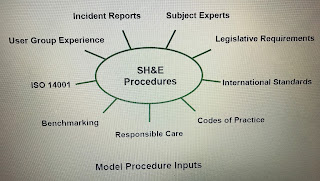• SH&E
is a line management responsibility. Ownership and accountability for SH&E
performance is embedded in the line at all levels and Line Managers are
responsible for providing SH&E leadership and for development and
implementation of SH&E management plans for their areas of
responsibility.
Next we need
to look at set of Model procedures.
The SH&E Model
Procedures provide detail on what has to be done to implement the SH&E
Policy and the SH&E Standards.
The Model Procedures are
used to facilitate compliance and capture best practice. They cover the full
range of SH&E activities and standard model procedures have been developed
by experts in the field (assisted with a range of inputs – see diagram below).
There are over 100
standard model procedures. Businesses are required to prioritise their
implementation of the Model Procedures based on a risk profile of their
activities and hence they logically address the most serious risks first. It is
a long-term goal to achieve and sustain compliance with the Key Requirements of
all the applicable Model Procedures.
The purpose of the prioritisation exercise is to give
sites some focus and allow them to proceed with their SH&E management in a
logical, risk-based manner, in order to develop a manageable program for
implementation of the Model Procedures. This is an effective way to better
utilise SH&E resources and avoid the dilution of the attention required to
manage significant risks that results from resources being spread across too
broad a range of activities.
Each Model Procedure
identifies the issues relating to a topic and describes practical controls to
be applied.
The Model Procedure Suites
are indexed as below:
• SH&E Management
• Safety
• Environment
• Engineering
• Health
Will discuss this further….


No comments:
Post a Comment